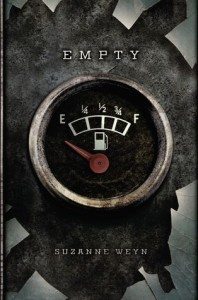Empty

Author: Suzanne Weyn
Release Date: October 10, 2010
Publisher: Scholastic Press
Source: Library!
Genre(s): YA, Dystopian, Apocalyptic
Spoilers: Mild
Rating: ★★★★☆
GoodReads | Amazon
If you’re looking for a dystopian that seems a little too realistic, look no further than Empty. This novel is based off the idea that in the not so distant future, the US has tapped out its petrol supply, and the rest of the world is running dry too. The only hope is a field in Venezuela, and naturally we go to war over it and the rising prices. A gallon of gas runs you $50-100, so only the mega rich can afford to drive anywhere, let alone run generators to keep electricity on and water hot. Everything we use that is based from oil is in short supply – gas, plastics, medicines, and food. And to make matters worse, they are seeing hurricanes worse than we’ve ever seen them before.
Luckily all of these calamity doesn’t mean the immediate downfall of civilization. No, first we’ve got a great deal of denial to deal with from across the board. In this novel we see the end of the world from three views, Gwen, a misfit girl with a secret she never wants out and a brother who deals with the black market. Tom, the second string football player with a huge heart. Nikki, the rich cheerleader who has never known a hard day before. Through the book we find Gwen and Tom growing closer, while Nikki and Tom sort out just what their feelings are for each other (don’t worry, it’s not a love triangle – more like typical high school drama). After the worst is over, they band together with the help of one of their teachers to find a new way to live that reduces their need for petroleum.
Sprinkled liberally throughout the book are “News Reports” from papers, radio, tv, etc. These lend a helping hand to those who like knowing more about the world the characters are in, and just what they are facing. I know most people would say that those are wasted space, but for me, it helped frame out the years the characters are in and just what we’re looking at as a whole. It is a very “green propaganda” book, as many other reviewers have pointed out, but who’s to say that is a bad thing? It’s the most realistic dystopian novel that I’ve read so far, and it never hurts to look ahead and see what you can change now to better the future.
Overall, the writing sometimes gets clunky, and the characters can be a little dry. However, the characters to me seemed pretty real. Most teenagers aren’t going to go nuts and start a war. Nor are they going to instantly know how to hunt and gather food from the wild. They are going to try to act as normal as possible and pretend it isn’t happening. It is a shorter read, clocking in at 183 pages. Easily a summer afternoon book to boost your summer reading numbers. It’s not overly engaging, but it does give you something to chew on for a while.
Final Thoughts:
I enjoyed this book. It isn’t one I’m going to go out and recommend everyone reads right now, but it’s one I’ll recommend for those friends who are into homesteading, climate change, or those looking for a fast book. For me it was enjoyable, and a one sitting read. I liked that the characters acted like normal teens, and that in the end they all came together to work towards a better world. If you don’t like books that talk about climate change and what could happen, this isn’t one for you. But if you do, check it out. Worst you’ll lose is a couple hours, and have to think a bit what life would be like without contacts and computers.
